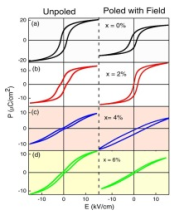Modulation of polar dynamics with oxygen vacancies in Zn doped BaZr0.1Ti0.9O3
| Abstract | Zinc modified barium zirconium titanate ceramics have been fabricated by the solid-state reaction method. Crystallographic analysis shows that the ceramics exhibit tetragonal crystal structure with P4mm symmetry. The polar behavior of Zn doped BaZr0.1Ti0.9O3 [BZT] differs from the pure BZT compound, as observed from ferroelectric analysis. As a result of doping, the P-E loops become pinched and linear in the low field region as well as P-E loop characteristics transformed from single hysteresis to double hysteresis behavior. Double hysteresis behavior emerging in BZT ferroelectrics validates the leading characteristic of defective dipoles. The defect dipoles provide restoring force to the spontaneous dipoles and ease the recovery of domain towards its original orientation. To validate the role of defects dipoles in the synthesized ceramics, we performed P-E hysteresis measurement under field cooling protocol. P-E loops of field cooled doped-ceramics transformed into single hysteresis curve and shifts on field scale, which further confirms that the double hysteresis feature is associated with defects dipoles rather than antiferroelectric ordering. The normalized entropy curves, ΔS(E,T,x)/ΔS^max (E,T_C,x), for x = 0 – 6%, follow the scheme of master curve with two reference temperatures and consistent with second-order phase transition theory. The dielectric spectroscopy and Arrott plot approach collectively reveal that Zn doping causes sharpening of Landau free energy profiles and doping increases the depth of double-well potential and lowers the polar dynamics. The room temperature energy storage efficiency (η~83,x=6%) of BZT is significantly modified. Our study reveals that the interplay between ferroelectric dipoles and point defects opens a novel route toward the realization of efficient energy storage performance. |
| Faculty |
Sanjeev Kumar
|
|
sanjeev@pec.edu.in
|
|
| More Information |







